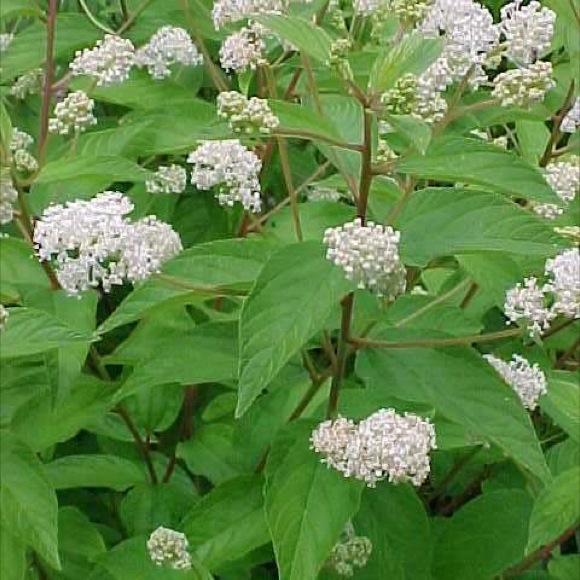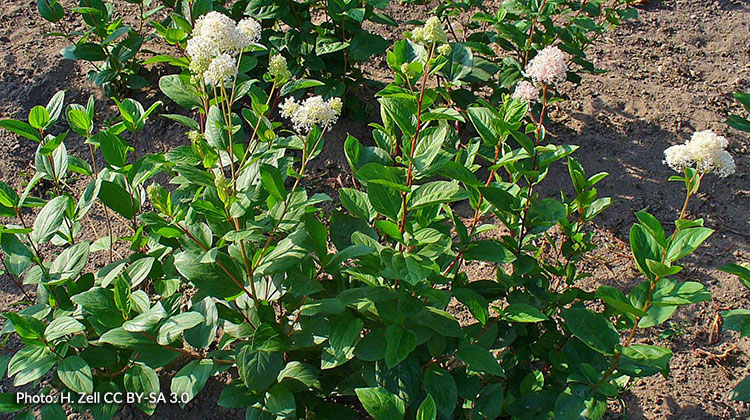new jersey tea plant uses
Billows of delicate white flowers form at the end of young branches in May and June. It is sometimes used as a hair tonic.

Ceanothus Americanus New Jersey Tea
New Jersey tea is a plant.

. An acidic pH level. Early pioneers discovered that the stout roots of New Jersey Tea Ceanothus americanus were a formidable barrier to the plow. New Jersey tea is used for gonorrhea syphilis colds cough fever chills spasms bleeding and pelvic cysts.
For best results plant your New Jersey tea in a soil mixture that is sandy loamy and well-draining. Thats because New Jersey tea shrubs are low maintenance plants that tolerate drought and thrive in dry soil shallow soil and rocky soil. The leaves have a fresh scent of wintergreen and were later utilized by the European colonizers as a tea substitute and stimulating caffeine -free beverage.
Dried caffeine free leaves when boiled a few minutes make a tea similar to Liptons regular. Current day usage of the roots concentrates on their astringent expectorant and antispasmodic actions and they are employed in the treatment of complaints such as asthma bronchitis and. New Jersey tea is a plant.
New Jersy Tea grows best in well-drained sandy loam or rocky soils in full sun to partial shade. Ad Compare Prices Read Reviews. New Jersey tea is used for gonorrhea syphilis colds cough fever chills spasms bleeding and pelvic cysts.
The roots and root bark of New Jersey. Full Shade Full Sun Partial SunShade Pests and Problems. 4 - 8 Mature Height.
Valued by Native American tribes for its medicinal uses and by early colonists as a tea substitute the New Jersey tea shrub today is prized in the home landscape. Drought Drowning and Edema Hardiness Zone. New Jersey tea plants will thrive best if located in a spot that boasts full sunlight.
Small Medium Large Exposure Light Requirements. Current day usage of the roots concentrates on their astringent expectorant and antispasmodic actions and they are employed in the. They serve well as ground cover for difficult areas of your backyard since they dont require much care.
Deer use the twigs throughout the year as a major food source. A green dye is also obtained from the flowers a cinnamon-colored dye from the whole plant and. A refreshing and stimulating tea is made from the dried leaves.
Grow them in the ground or keep them in large outdoor containers to decorate the bend in a garden path or flanking either side of your garden gate. How does it work. Animal research suggests it might shorten the time it takes for blood to clot.
The root root bark and leaf of the plant have been used to make medicine. How does it work. A decoction of the bark is used as a skin wash for cancer and venereal sores.
The leaves are gathered when the plant is in fell bloom and are dried in the shade. In the wild New Jersey tea is typically found in rocky areas sandy areas glades open woods prairies and abandoned. Chemical compounds from this plant have been found to affect the speed of blood coagulation Lynch et.
New Jersey Tea Ceanothus americanus. How to Use New Jersey Tea in the Landscape This low-maintenance selection makes an exceptional accent plant. Animal research suggests it might shorten the time it takes for blood to clot.
One of New Jerseys common names is soap bloom. The flowers and developing seed pods of New Jersey Tea can be used as a fragrant soap or body wash even producing a lather when combined with water. They have a stimulatory effect on the lymphatic system while an alkaloid in the roots is mildly hypotensive.
It works well as part of a mixed bed in a foundation planting and as a ground holder for rocky slopes or a ground cover for thin dry and rocky soils. Flowers of New Jersey Tea. New Jersey Tea Ceanothus americanus features glossy leaves numerous bright white flowers and a mounding shape that make this compact shrub a popular garden member.
Was a substitute for tea during the American revolution. At maturity the New Jersey Tea can reach heights of 3 feet. The roots and root bark of New Jersey tea was used extensively by the North American Indians to treat fevers and problems of the mucous membranes such as catarrh and sore throats.
New Jersey tea Ceanothus americanus is a plant. The astringent leaves were used by colonists as a substitute for imported tea during the American Revolution. A low-growing compact shrub thats excellent for hot dry sites.
People use the root root bark and leaf to make medicine. Why is this plant named after the Colony later State of New Jersey. It is not known how New Jersey tea might work.
Free Shipping on Qualified Orders. The plant fixes nitrogen through its symbiosis with bacteria. However if being grown in an area that is especially.
21 rows Traditional and Medicinal Uses of New Jersey Tea. Constituents and medicinal use The red roots and root bark of New Jersey tea are used by Native Americans in North America for infections of the upper respiratory tract. The plant is used internally in the treatment of bronchial complaints including asthma and whooping cough dysentery sore throats tonsillitis hemorrhoids etc.
People use the root root bark and leaf to make medicine. My sources remain silent on that point. It is drought tolerant once established and tolerates road salt.
Because of its deep root system it is great for use in erosion control on slopes but this also makes it difficult to transplant. It was used by colonists during the Revolutionary War as a substitute for tea hence the common name even though the leaves contain no caffeine. Clusters of small black fruit form in July and August.
New Jersey Tea Care. Also effective as a shrubby ground cover for hard-to-grow areas such as dry rocky slopes and banks. It is not known how New Jersey tea might work.
It is a small shrub usually less than 3 feet 1 meter tall with tiny white flowers in erect oval clusters. In fact New Jersey tea shrub care is minimal. Shrub borders or native plant gardens.
Medicinal use of New Jersey Tea. New Jersey tea Ceanothus americanus is a low-growing native shrub that can be found throughout most of the eastern half of the USIt is an interesting plant from both an ecological standpoint and from a historical ethnobotanical standpoint. The roots and root bark of New Jersey tea was used extensively by the North American Indians to treat fevers and problems of the mucous membranes such as catarrh and sore throats254.
This tea does not contain caffeine. Planted two to three feet apart it forms an attractive low growing hedge and is an excellent choice for rocky hillsides and slopes as well.

New Jersey Tea Ceanothus Americanus 3 Pack Of Pots Blazing Star Gardens

New Jersey Tea Ceanothus Americanus 3 Pack Of Pots Blazing Star Gardens

New Jersey Tea Eat The Weeds And Other Things Too

New Jersey Tea Ceanothus Americanus Cowling Arboretum Carleton College
Ceanothus Americanus New Jersey Tea Native Plants Of North America

Ceanothus Americanus Or New Jersey Tea Is A Small But Fast Growing Shrub About 1 2m Can Be Uses As A Tea Substitute Plants Growing Shrubs Fast Growing Shrubs
Ceanothus Americanus New Jersey Tea From New Moon Nurseries
Ceanothus Americanus New Jersey Tea From New Moon Nurseries
Ceanothus Americanus New Jersey Tea Minnesota Wildflowers

Red Root Uses Benefits Side Effects And Dosage

New Jersey Tea Ceanothus Americanus 3 Pack Of Pots Blazing Star Gardens

New Jersey Tea Ceanothus Americanus 3 Pack Of Pots Blazing Star Gardens

Ceanothus Americanus Mountain Snowbell New Jersey Tea North Carolina Extension Gardener Plant Toolbox

Ceanothus Americanus Mountain Snowbell New Jersey Tea North Carolina Extension Gardener Plant Toolbox

New Jersey Tea Ceanothus Americanus 3 Pack Of Pots Blazing Star Gardens

New Jersey Tea Ceanothus Americanus Prairie Nursery

New Jersey Tea Ceanothus Americanus 3 Pack Of Pots Blazing Star Gardens
Ceanothus Americanus New Jersey Tea Minnesota Wildflowers

Growing Native New Jersey Tea Ceanothus Americanus Melinda Myers